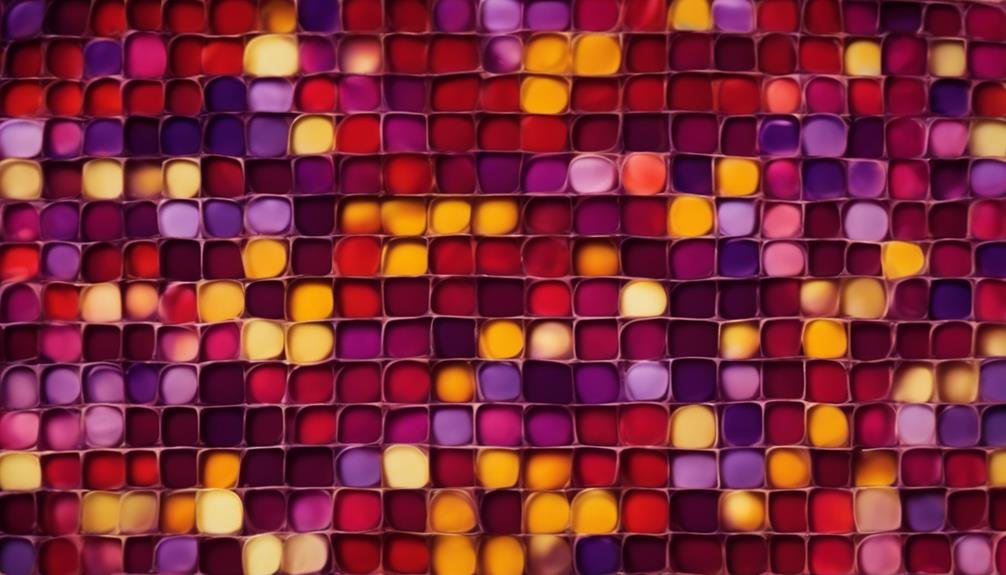Discover the fascinating evolution of wine colors: Red wines shift from vivid shades to elegant garnet as anthocyanin diminishes over time. White wines deepen from light yellows to rich browns with aging. Factors like fermentation temperature, grape maceration, oxidation, and pH levels influence the final hue. Lower pH levels yield intense reds, while violet tones relate to pH 3.4–3.6, and bluer hues indicate higher pH values. Understanding these dynamics enhances your wine appreciation journey. Explore the mesmerizing interplay of elements that shape the colors in your glass, revealing a world of sensory delights.
Wine Color Aging Process
The aging process of wine color is a natural evolution that heavily impacts the visual appearance and characteristics of the wine over time. As red wines mature, they tend to lose their vibrant hues, shifting towards more garnet tones and eventually developing brownish tinges. This color transformation is primarily driven by the gradual loss of anthocyanin, a key pigment responsible for the intense red color in young wines.
Studies show that up to 85% of anthocyanin can be lost after five years of aging, leading to significant changes in the wine's visual appeal. Conversely, white wines undergo a darkening process with age, evolving from pale yellows to deeper gold shades and ultimately to brown hues, reflecting their own unique aging journey.
Factors Influencing Wine Color
Influence over the coloration of wine is attributed to a myriad of factors. Temperature during fermentation plays a pivotal role, as red wines fermented at higher temperatures tend to have reduced color intensity. Additionally, grape maceration, where rosé wines derive their pink hue from red grape skin contact, impacts the final color. Oxidation can turn wine brown, while pH levels influence the red wine color spectrum. Co-pigmentation and sulfur additions also affect the overall color profile.
Understanding these factors sheds light on the complexity of wine coloration, with each element contributing uniquely to the final visual appeal of the wine in your glass.
Color Hue and Ph Relationships

Examining the correlation between color hue and pH levels in wine reveals intricate nuances that contribute greatly to its visual presentation and taste profile. pH levels play a significant role in determining the color intensity of wine. Wines with a strong red hue typically have lower pH levels, indicating higher acidity. Those with violet hues tend to range around 3.4–3.6 pH. In contrast, blueish-tinted wines usually have pH levels over 3.6, indicating lower acidity.
Understanding this relationship between color hue and pH levels provides valuable insights into the characteristics of different wines and can help wine enthusiasts appreciate the nuances in both visual appearance and taste. By considering pH levels alongside color intensity, one can gain a deeper understanding of the complexity that contributes to the overall wine experience.
Frequently Asked Questions
How Does the Type of Wine Glass Affect the Perception of Wine Color?
The type of wine glass influences wine color perception. Glass shape can concentrate colors, altering their appearance. Color psychology suggests that the hue of wine can impact taste perception. Choosing the right glass can enhance the overall sensory experience.
Can Different Lighting Conditions Impact How We See the Color of Wine?
Different lighting conditions can indeed impact how we perceive wine color. Natural lighting can enhance the vibrancy of hues, while artificial lighting may alter the appearance. Understanding how light interacts with wine colors can enrich the overall sensory experience.
Does the Color of the Label on the Wine Bottle Influence Our Perception of Its Color?
The color of the label on a wine bottle can influence our perception of its color. Research shows that labels with warm tones like red may lead us to perceive the wine as darker and richer in color.
Are There Regional Differences in How Wine Color Is Described or Appreciated?
Regional preferences and cultural differences play a significant role in how wine color is described and appreciated. Various regions may emphasize different aspects of wine color, influenced by traditions, local tastes, and winemaking practices, contributing to diverse perceptions and preferences.
Can the Temperature of the Wine Impact How We Perceive Its Color Intensity?
The serving temperature of wine can indeed impact how we perceive its color intensity. Fluctuations in temperature can influence visual perception, affecting color consistency and altering the wine's appearance based on serving style.
Conclusion
To summarize, gaining an understanding of wine colors is a captivating journey that offers valuable insights into the aging process, varietal characteristics, and winemaking techniques.
While some may argue that taste is the most important aspect of wine appreciation, the visual cues provided by color can enhance our overall sensory experience and deepen our understanding of the complexities of wine.
Embracing the nuances of wine colors reveals a deeper appreciation for the art and science behind this beloved beverage.